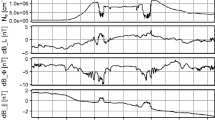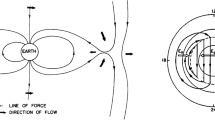Abstract
The ionospheric gravity and pressure-gradient current systems are most prominent in the low-latitude \(F\)-region due to the plasma density enhancement known as the equatorial ionization anomaly (EIA). This enhancement of plasma density which builds up during the day and lasts well into the evening supports a toroidal gravity current which flows eastward around the Earth in the \(F\)-region during the daytime and evening, and eventually returns westward through the \(E\)-region. The existence of pressure-gradients in the EIA region also gives rise to a poloidal diamagnetic current system, whose flow direction acts to reduce the ambient geomagnetic field inside the plasma. The gravity and pressure-gradient currents are among the weaker ionospheric sources, with current densities of a few \(\mbox{nA/m}^{2}\), however they produce clear signatures of about 5–7 nT in magnetic measurements made by low-Earth orbiting satellites. In this work, we review relevant observational and modeling studies of these two current systems and present new results from a 3D ionospheric electrodynamics model which allows us to visualize the entire flow pattern of these currents throughout the ionosphere as well as calculate their magnetic perturbations.








Similar content being viewed by others
References
P. Alken, Observations and modeling of the ionospheric gravity and diamagnetic current systems from CHAMP and Swarm measurements. J. Geophys. Res. Space Phys. (2016). doi:10.1002/2015JA022163
P. Alken, S. Maus, A.D. Richmond, A. Maute, The ionospheric gravity and diamagnetic current systems. J. Geophys. Res. (2011). doi:10.1029/2011JA017126
D.N. Anderson, Modeling the ambient, low latitude F-region ionosphere – a review. J. Atmos. Terr. Phys. 43(8), 753–762 (1981)
W. Baumjohann, R.A. Treumann, Basic Space Plasma Physics (Imperial College Press, London, 1997)
D. Bilitza, L.-A. McKinnell, B. Reinisch, T. Fuller-Rowell, The International Reference Ionosphere (IRI) today and in the future. J. Geod. 85, 909–920 (2011). doi:10.1007/s00190-010-0427-x
F.F. Chen, Introduction to Plasma Physics and Controlled Fusion, 2nd edn. Plasma Physics, vol. 1 (Springer, New York, 2006)
A. Chulliat, S. Maus, Geomagnetic secular acceleration, jerks, and a localized standing wave at the core surface from 2000 to 2010. J. Geophys. Res., Solid Earth 119, 1531–1543 (2014). doi:10.1002/2013JB010604
V. Doumbia, A. Maute, A.D. Richmond, Simulation of equatorial electrojet magnetic effects with the thermosphere-ionosphere-electrodynamics general circulation model. J. Geophys. Res. 112(A9), A09309. (2007). doi:10.1029/2007JA012308
M.W. Dunlop, J.-Y. Yang, Y.-Y. Yang, C. Xiong, H. Lühr, Y.V. Bogdanova, C. Shen, N. Olsen, Q.-H. Zhang, J.-B. Cao, H.-S. Fu, W.-L. Liu, C.M. Carr, P. Ritter, A. Masson, R. Haagmans, Simultaneous field-aligned currents at Swarm and Cluster satellites. Geophys. Res. Lett. 42(10), 3683–3691 (2015). doi:10.1002/2015GL063738
J.V. Eccles, The effect of gravity and pressure in the electrodynamics of the low-latitude ionosphere. J. Geophys. Res. (2004). doi:10.1029/2003JA010023
J.M. Forbes, The equatorial electrojet. Rev. Geophys. Space Phys. 19(3), 469–504 (1981)
E. Friis-Christensen, H. Lühr, G. Hulot, Swarm: a constellation to study the Earth’s magnetic field. Earth Planets Space 58, 351–358 (2006)
M.C. Kelley, The Earth’s Ionosphere: Plasma Physics and Electrodynamics. International Geophysics Series (Academic Press Inc., San Diego, 1989). 9780124040137
K. Laundal, A.D. Richmond, Magnetic coordinate systems. Space Sci. Rev. (2016, submitted)
F.J. Lowes, Measuring magnetic field in the ‘diamagnetic’ ionosphere. Geophys. J. Int. 171(1), 115–118 (2007). doi:10.1111/j.1365-246X.2007.03506.x
G.M. Lucas, A.J.G. Baumgaertner, J.P. Thayer, A global electric circuit model within a community climate model. J. Geophys. Res., Atmos. 120(23), 12054–12066 (2015). doi:10.1002/2015JD023562
H. Lühr, S. Maus, Direction observation of the F region dynamo currents and the spatial structure of the EEJ by CHAMP. Geophys. Res. Lett. (2006). doi:10.1029/2006GL028374
H. Lühr, S. Maus, Solar cycle dependence of quiet-time magnetospheric currents and a model of their near-Earth magnetic fields. Earth Planets Space 62, 843–848 (2010)
H. Lühr, M. Rother, S. Maus, W. Mai, D. Cooke, The diamagnetic effect of the equatorial Appleton anomaly: its characteristics and impact on geomagnetic field modeling. Geophys. Res. Lett. 30(17), 1906 (2003). doi:10.1029/2003GL017407
H. Lühr, S. Maus, M. Rother, Noon-time equatorial electrojet: Its spatial features as determined by the CHAMP satellite. J. Geophys. Res. (2004). doi:10.1029/2002JA009656
H. Lühr, J. Park, C. Xiong, J. Rauberg, Alfvén wave characteristics of equatorial plasma irregularities in the ionosphere derived from CHAMP observations. Front. Phys. (2014a). doi:10.3389/fphy.2014.00047
H. Lühr, C. Xiong, J. Park, J. Rauberg, Systematic study of intermediate-scale structures of equatorial plasma irregularities in the ionosphere based on CHAMP observations. Front. Phys. (2014b). doi:10.3389/fphy.2014.00015
H. Lühr, G. Kervalishvili, I. Michaelis, J. Rauberg, P. Ritter, J. Park, J.M.G. Merayo, P. Brauer, The interhemispheric and F region dynamo currents revisited with the Swarm constellation. Geophys. Res. Lett. 42(9), 3069–3075 (2015). doi:10.1002/2015GL063662
H. Lühr, G. Kervalishvili, J. Rauberg, C. Stolle, Zonal currents in the F region deduced from Swarm constellation measurements. J. Geophys. Res. 121, 638–648 (2016). doi:10.1002/2015JA022051
C. Manoj, H. Lühr, S. Maus, N. Nagarajan, Evidence for short spatial correlation lengths of the noontime equatorial electrojet inferred from a comparison of satellite and ground magnetic data. J. Geophys. Res. (2006). doi:10.1029/2006JA011855
S. Marsal, A.D. Richmond, A. Maute, B.J. Anderson, Forcing the TIEGCM model with Birkeland currents from the Active Magnetosphere and Planetary Electrodynamics Response Experiment. J. Geophys. Res. 117(A6), A06308 (2012). doi:10.1029/2011JA017416
S. Maus, H. Lühr, Signature of the quiet-time magnetospheric magnetic field and its electromagnetic induction in the rotating Earth. Geophys. J. Int. 162, 755–763 (2005). doi:10.1111/j.1365-246X.2005.02691.x
S. Maus, H. Lühr, A gravity-driven electric current in the Earth’s ionosphere identified in CHAMP satellite magnetic measurements. Geophys. Res. Lett. (2006). doi:10.1029/2005GL024436
S. Maus, M. Rother, C. Stolle, W. Mai, S. Choi, H. Lühr, D. Cooke, C. Roth, Third generation of the Potsdam Magnetic Model of the Earth (POMME). Geochem. Geophys. Geosyst. (2006). doi:10.1029/2006GC001269
S. Maus, H. Lühr, M. Rother, K. Hemant, G. Balasis, P. Ritter, C. Stolle, Fifth-generation lithospheric magnetic field model from CHAMP satellite measurements. Geochem. Geophys. Geosyst. 8(5), Q05013 (2007). doi:10.1029/2006GC001521
S. Maus, C. Manoj, J. Rauberg, I. Michaelis, H. Lühr, NOAA/NGDC candidate models for the 11th generation International Geomagnetic Reference Field and the concurrent release of the 6th generation Pomme magnetic model. Earth Planets Space 62, 729–735 (2010)
A. Maute, A.D. Richmond, F-region dynamo simulations at low and mid-latitude. Space Sci. Rev. (2016, this issue). doi:10.1007/s11214-016-0262-3
J. Park, R. Ehrlich, H. Lühr, P. Ritter, Plasma irregularities in the high-latitude ionospheric F-region and their diamagnetic signatures as observed by CHAMP. J. Geophys. Res. 117(A10), A10322 (2012). doi:10.1029/2012JA018166
L. Qian, A.G. Burns, B.A. Emery, B. Foster, G. Lu, A. Maute, A.D. Richmond, R.G. Roble, S.C. Solomon, W. Wang, in The NCAR TIE-GCM, ed. by J. Huba, R. Schunk, G. Khazanov (Wiley, New York, 2014), pp. 73–83. doi:10.1002/9781118704417.ch7
C. Reigber, H. Lühr, P. Schwintzer, First CHAMP Mission Results for Gravity, Magnetic and Atmospheric Studies (Springer, Berlin, 2003). doi:10.1007/978-3-540-38366-6
A.D. Richmond, The computation of magnetic effects of field-aligned magnetospheric currents. J. Atmos. Terr. Phys. 36(2), 245–252 (1974). doi:10.1016/0021-9169(74)90044-0
A.D. Richmond, Ionospheric wind dynamo theory: a review. J. Geomagn. Geoelectr. 31, 287–310 (1979)
A.D. Richmond, Modeling the ionosphere wind dynamo: a review. Pure Appl. Geophys. 131(3), 413–435 (1989)
A.D. Richmond, Ionospheric electrodynamics using magnetic apex coordinates. J. Geomagn. Geoelectr. 47, 191–212 (1995a)
A.D. Richmond, in The Ionospheric Wind Dynamo: Effects of Its Coupling With Different Atmospheric Regions, ed. by R.M. Johnson, T.L. Killeen (American Geophysical Union, Washington, 1995b), pp. 49–65. doi:10.1029/GM087p0049
A.D. Richmond, in Ionospheric Electrodynamics, ed. by G. Khazanov (CRC Press, Boca Raton, 2016), pp. 245–259. Chap. 14, in press
A.D. Richmond, A. Maute, in Ionospheric Electrodynamics Modeling, ed. by J. Huba, R. Schunk, G. Khazanov (Wiley, New York, 2014), pp. 57–71. doi:10.1002/9781118704417.ch6
H. Rishbeth, The F-layer dynamo. Planet. Space Sci. 19, 263–267 (1971)
H. Rishbeth, The F-region dynamo. J. Atmos. Terr. Phys. 43, 387–392 (1981)
H. Rishbeth, The ionospheric E-layer and F-layer dynamos—a tutorial review. J. Atmos. Sol.-Terr. Phys. 59(15), 1873–1880 (1997). doi:10.1016/S1364-6826(97)00005-9
P. Ritter, H. Lühr, J. Rauberg, Determining field-aligned currents with the Swarm constellation mission. Earth Planets Space 65(11), 1285–1294 (2013). doi:10.5047/eps.2013.09.006
R. Schunk, A. Nagy, Ionospheres: Physics, Plasma Physics, and Chemistry, 2nd edn. Cambridge Atmospheric and Space Science Series (Cambridge University Press, New York, 2009)
R.J. Stening, Modelling the low latitude F region. J. Atmos. Terr. Phys. 54(11–12), 1387–1412 (1992). doi:10.1016/0021-9169(92)90147-D
C. Stolle, H. Lühr, M. Rother, G. Balasis, Magnetic signatures of equatorial spread F as observed by the CHAMP satellite. J. Geophys. Res. 111(A2), A02304 (2006). doi:10.1029/2005JA011184
C. Stolle, C. Manoj, H. Lühr, S. Maus, P. Alken, Estimating the day time Equatorial Ionization Anomaly strength from electric field proxies. J. Geophys. Res. (2008). doi:10.1029/2007JA012781
R. Tozzi, M. Pezzopane, P. De Michelis, M. Piersanti, Applying a curl-B technique to Swarm vector data to estimate nighttime F region current intensities. Geophys. Res. Lett. 42(15), 6162–6169 (2015). doi:10.1002/2015GL064841
K.Z. Zaka, A.T. Kobea, V. Doumbia, A.D. Richmond, A. Maute, N.M. Mene, O.K. Obrou, P. Assamoi, K. Boka, J.-P. Adohi, C. Amory-Mazaudier, Simulation of electric field and current during the 11 June 1993 disturbance dynamo event: comparison with the observations. J. Geophys. Res. Space Phys. 115(A11), A11307 (2010). doi:10.1029/2010JA015417
Acknowledgements
The National Center for Atmospheric Research is sponsored by the National Science Foundation (NSF). A. M. and A.D. R. were supported by NSF award AGS-1135446. We gratefully acknowledge graphics support from the NCEI visual communications team and Deborah Misch of LMI Consulting.
Author information
Authors and Affiliations
Corresponding author
Rights and permissions
About this article
Cite this article
Alken, P., Maute, A. & Richmond, A.D. The \(F\)-Region Gravity and Pressure Gradient Current Systems: A Review. Space Sci Rev 206, 451–469 (2017). https://doi.org/10.1007/s11214-016-0266-z
Received:
Accepted:
Published:
Issue Date:
DOI: https://doi.org/10.1007/s11214-016-0266-z




